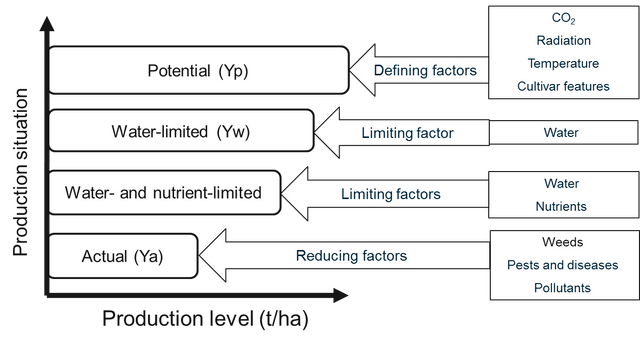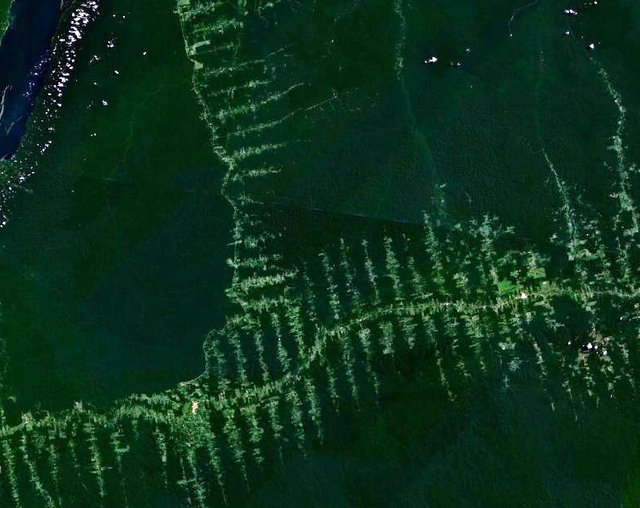What is the Yield Gap and why closing it should be #1 priority
Global food production will probably have to increase between 60 and 100% in the following decades if we want to feed the current global population and changing dietary habits. Sadly we have not yet colonized another planet or discovered magic, so this increase will have to come from either expanding agricultural land, or by increasing crop yield. Expansion comes at the cost of losing various ecosystem services but also intensification can cause loss of biodiversity and dead zones due to excessive runoff of chemicals. When looking for the best solution, understanding the Yield Gap that is currently present gets increasingly important.
What gap?
The yield gap is a term to define the gap between potential crop yields in a certain region and the actual harvested yields with the crops currently grown. The reasons for this difference in crop yields can biologically be determined as lack of water/nutrients, pests and diseases, but on a higher level these can be attributed to various factors such as bad land management, lack of access to the market, severe weather conditions or even political factors. The maximal potential yield is defined as the yield with optimal conditions such as optimal sowing date, species variety, nutrients, pests, diseases and weeds not limiting growth.
Global yield gap map by Pradhan, Fischer, Van Velthuizen, Reusser, & Kropp (2015). Values close to 1 indicate regions where actual yield is close to the potential yield.
When potential yields are simulated (by the FAO, taking climatic variations into account), and compared to actual yields on the map, the regions with growth potential clearly become visible. It can be stated that the maximal potential yields are close to achieved in most of the Western world and China, while other major regions such as Central and Southern America, Africa and Central Eurasia can still attain significant yield gains.
The different production levels based on plant growth as stated by van Ittersum et al (2013)
is estimated that at least a 50% increase in crop production can be attained when the full potential of agricultural yield is used. Meaning that improving farming efficiency could be equally effective as expanding cropland by the size of Australia. Throw in some extra dietary changes such as less meat (preferably less lamb, beef and pork) and less farmed fish and you have a great mix for feeding an increasing global population.
How to close the gap
The causes of the gap is variable and there is no one limiting factor. Each region is different and has special needs. Moreover a combination of factors need to be addressed.
As seen in the illustration, Yield gap difference can be separated by only a border, indicating that it is not only a regional effect, but also induced by changes in policies. Especially visible between the German - Polish border. Data publicly available from the Global Yield Gap Atlas. If you want to experiment with this data, I can highly recommend their tool here.
'Fishbone deforestation', a clear pattern where cultivated land is expanded for subsistence farming. Commercial, large scaled deforestation takes on an entirely different pattern. Satellite image from NASA under public domain.
Agriculture in regions with a high yield gap is prominently subsistence farming. For sub-Saharan Africa and Asia, subsistence farming makes up about 80% of the food production (Africa Agriculture Status Report 2017). Lack of clear property rights also make it easy to expand your cultivated land which takes away the incentive to increase farming efficiency. This expansion of cultivated land is clearly visible in the 'fishbone' deforestation present in the Amazon.
Often market access is limited and both the fertilizers and the knowledge to use them are much harder to come by. This combined with a lack of managed farming practices lead to the reduced yields currently observed.
Informing these farmers is no doubt a great investment, and putting effort in infrastructure to increase market access will vastly improve yields. There are already many initiatives from universities and foundations, one of them being the Gates foundation. The Gates foundation spends millions of dollars yearly on key elements such as bringing the right crop variety to where it is needed, improving market accessibility, minimizing crop/livestock waste due to spoilage, weeds, pests... and improving soil/water management, while also training local's skills, support certain policies and gathering data.
Conclusion
There is clearly room for improvement and many with the power to act have noticed this as well. The initiatives are out there and it is only a matter of time before progress is made. As always in the real world, there is no one silver bullet. Having closed the yield gap will not solve all world's problems, but since food us such an essential element of everyone's lives it surely is a step in the right direction. Just imagine if food was no longer a scarcity and well distributed around the world. Is there something I got wrong or do you want to make an addition? I'm always open for other perspectives or corrections!
Sources
Mondal, M. H. (2011). Causes Of Yield Gaps And Strategies For Minimizing The Gaps In Different Crops Of Bangladesh. Bangladesh Journal of Agricultural Research, 36(September), 469–476. https://doi.org/10.3329/bjar.v36i3.9274
Pradhan, P., Fischer, G., Van Velthuizen, H., Reusser, D. E., & Kropp, J. P. (2015). Closing yield gaps: How sustainable can we be? PLoS ONE, 10(6), 1–18. https://doi.org/10.1371/journal.pone.0129487
Sadras, V. O., Cassman, K. G. G., Grassini, P., Hall, A. J., Bastiaanssen, W. G. M., Laborte, A. G., … Steduto, P. (2015). Yield gap analysis of field crops, Methods and case studies. FAO Water Reports (Vol. 41).
AGRA. (2017). Africa Agriculture Status Report: The Business of Smallholder Agriculture in Sub-Saharan Africa. Alliance for a Green Revolution in Africa (AGRA, (5), 180 PP. https://doi.org/http://hdl.handle.net/10568/42343
https://green.blogs.nytimes.com/2011/06/07/can-the-yield-gap-be-closed-sustainably/
https://www.gatesfoundation.org/What-We-Do/Global-Growth-and-Opportunity/Agricultural-Development


This is informative content. Thanks for sharing😊
This post has been upvoted by the user-run curation platform CI! In this platform users are able to manually curate content. This is done regardless of Steem Power, for both rewards and vote size calculation.
Join in at our site here!
https://collectiveintelligence.red/
Or join us on discord to interact with the community!
https://discord.gg/sx6dYxt
This post was submitted for curation by: @anevolvedmonkey
This post was given a rating of: 0.9932109739612306
This post was voted: 100%
wow thanks! I'll make sure to check this out!
Hah! I can't believe I missed that pun!
Great article but had to say it...
Hi @samve!
Your post was upvoted by @steem-ua, new Steem dApp, using UserAuthority for algorithmic post curation!
Your UA account score is currently 2.450 which ranks you at #16602 across all Steem accounts.
Your rank has not changed in the last three days.
In our last Algorithmic Curation Round, consisting of 597 contributions, your post is ranked at #555.
Evaluation of your UA score:
Feel free to join our @steem-ua Discord server
This post has been voted on by the steemstem curation team and voting trail.
There is more to SteemSTEM than just writing posts, check here for some more tips on being a community member. You can also join our discord here to get to know the rest of the community!
thanks! I appreciate the efforts!